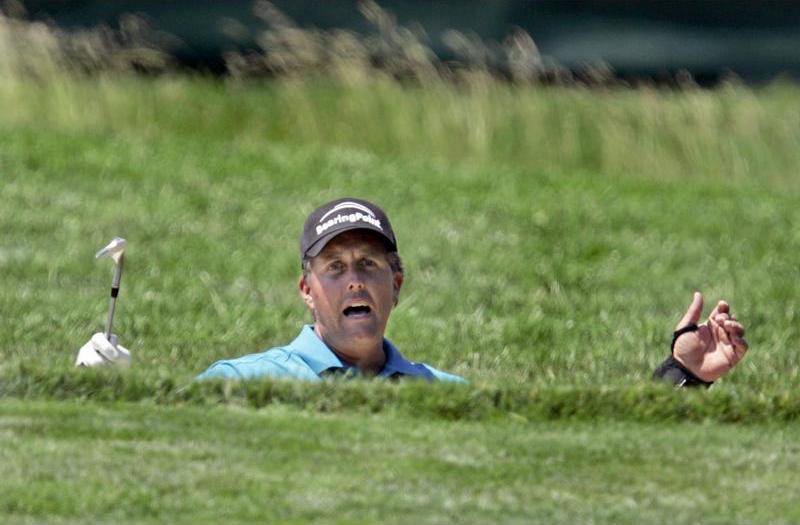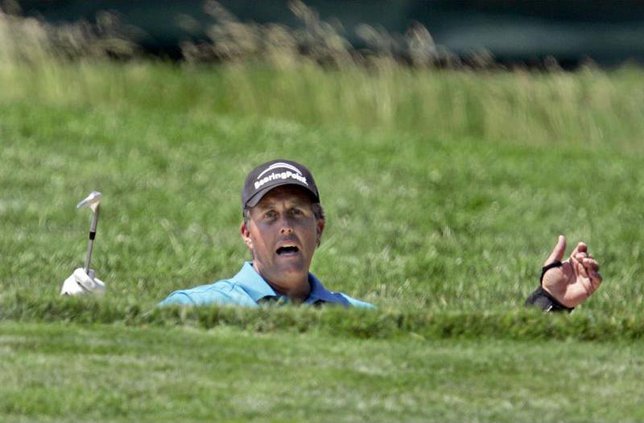OAKMONT, Pa. — Angel Cabrera was the last survivor to par Friday, but only because of an amazing birdie on his final hole that made Phil Mickelson extinct at this U.S. Open.
Cabrera finished off a calamitous day at Oakmont with a sand wedge from 135 yards that skipped to a stop about a foot from the hole, giving him a 1-over 71 and a one-shot lead over Bubba Watson. That put him at even-par 140 and knocked 19 players out of the tournament under the Open’s 10-shot rule.
No casualty was more significant than Mickelson.
Trying to recover from a broken heart last year at Winged Foot and a left wrist injury he blamed on Oakmont’s rough, Mickelson missed the cut for the first time in 31 majors dating to the 1999 British Open at Carnoustie.
Mickelson figured he had no chance when he signed for a 77, saying he would ‘‘go watch the carnage on TV.’’
That it was.
Greens that had been cut three times and rolled twice, combined with warm sunshine that cooked the course, led to only two rounds under par and the highest weekday scoring at a U.S. Open in 21 years.
‘‘I don’t know what the average score was, but I think I shot under par,’’ Tiger Woods said after salvaging a 74 that put him five back.
Even more shocking than the toughness of Oakmont was seeing Paul Casey with a 66, a round so superb that players on the practice green who watched him finish on No. 9 applauded when he knocked in his final putt.
That was 11 shots better than the average score.
‘‘I consider the U.S. Open to be the toughest test in golf,’’ Casey said. ‘‘This is possibly the toughest golf course I’ve ever played, and I feel very, very lucky to have shot 66 on it. There is no rest out there.’’
And there might not be any relief in sight.
The USGA said it would water the greens overnight, but with more sunshine in the forecast, Oakmont figures to get even more brutal.
Stephen Ames had the other subpar round (69), leaving him at 142 along with Aaron Baddeley (70), Justin Rose (71) and Niclas Fasth (71). Casey was at 143, with David Toms in the group another shot behind.
‘‘It’s a real test of golf, all the way through,’’ Watson said. ‘‘Just walking through the parking lot is tough.’’
The USGA, as usual, offered no apologies.
Never mind that no one was under par after 36 holes for the first time since 1974 at Winged Foot. Or that the scoring average was the highest before the cut was made at the U.S. Open since 77.8 in the wind-blown first round at Shinnecock Hills in 1986. Or that 35 players, including Adam Scott and Padraig Harrington, failed to break 80.
‘‘It’s a hard golf course. We’ve said that all along,’’ said Jim Hyler, head of the championship committee for the USGA.
Mickelson wasn’t the only one checking out at Oakmont. Five of the top 10 players in the world ranking failed to make the cut, the others being Scott, Henrik Stenson, Luke Donald and Retief Goosen.
Trevor Immelman leaned against a wall in the locker room after a 79 that eventually sent him home. He stared blankly at the television, watching other players suffer, trying to come to grips with how Casey posted five birdies and only one bogey.
‘‘The greatest round I’ve ever seen in my life,’’ said Immelman, who played with the Englishman. ‘‘He beat me by 13 shots. That’s almost giving him one shot per hole.’’
Casey didn’t exactly have his way with Oakmont. He birdied the two toughest holes in the second round, including a 45-foot putt on the treacherous 10th green. And he saved a couple of pars with putts that felt as though they would slide off the green if the hole didn’t happen to get in the way.
‘‘I know the scores are quite high today and I shot a low number,’’ Casey said. ‘‘But I don’t think we’ve seen half of Oakmont yet.’’
The only other time Cabrera has had the lead in a major was three years ago after the first round at Shinnecock Hills. Watson, the biggest hitter on the PGA Tour who is using several irons to keep the ball in play, is playing in his first U.S. Open and hasn’t won anything since the Hooters Tour four years ago.
Along with a challenging course, they now must cope with the nerves of playing in the last group on the weekend at a major.
‘‘I’m always nervous,’’ Watson said. ‘‘The U.S. Open is going to be bigger crowds, and I’m going to be just as nervous and feel like throwing up the whole time.’’
Indeed, it was a sick feeling for everyone.
David Toms had a share of the lead for the second straight day, but like so many other players, Oakmont eventually got the best of him. He bogeyed five of his last six holes Thursday, and played his last five holes Friday in 4 over par.
Even so, he was at 144, along with Scott Verplank (71) and Brandt Snedeker (73).
‘‘They teased us yesterday with some of the easy pin positions, and today when you woke up, they let you know we’re at Oakmont,’’ Snedeker said. ‘‘It’s just going to be a tough round of golf.’’
Woods figured that out when he started to hit his tee shots into the ankle-deep rough, and it really hit home when his approach landed on the front part of the first green and never had a chance to go anywhere but into the rough.
‘‘Thank God I had spikes on, because I think I would have slipped right off the back,’’ he said.
His ugliest hole saved his round — an iron he pulled into the rough, a second shot that caromed off the bank and into the bottom of a shallow ditch, a third shot into a bunker on the other side of the green, and an up-and-down for bogey.
It is days like this that make players wonder whether the U.S. Open is any fun or the course is fair.
‘‘It’s a mean course,’’ Jim Furyk said after a 75 put him at 6-over 146. ‘‘Rarely do you hit a marginal shot and get away with it. And oftentimes, you hit a pretty darn good shot and it doesn’t turn out well.’’





